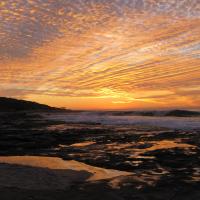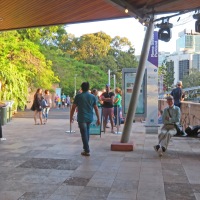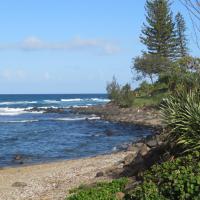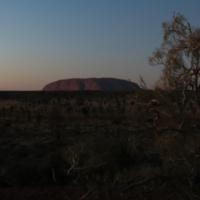Winter is finally here. A shroud of cloud and misty rain has hidden the majestic Mount Wellington for a week. The temperatures are dropping. Yesterday a break in the clouds revealed the summit.
With only 14 days left in Hobart I did not want to waste the opportunity for a bus ride to the signal station on Mount Nelson whilst it was visible. So using my $3-20 “all day concession pass” I hopped aboard a local Metro bus.
If Mt Wellington is under a cloud, the much lower Old Signal Station on Mt Nelson still provides excellent views. When Port Arthur was operating as a penal site, a series of semaphore stations were positioned on all the high hills and used to transmit messages across the colony. The one on Mt Nelson – first established in 1811, though the current building dates from 1910 – served as the major link between Hobart and the rest of the colony.
The road is narrow and with very sharp bends it requires skilled driving to manoeuvre the large Metro bus round the curves. Cars coming in the opposite direction have to pull to the very edge of the road and stop as the bus swings right across the road to turn these sharp bends.
The day is overcast and grey, not ideal for photography, but I still wander around recording what I see. The signal station was used in the 1800’s to pass semaphore signals, using flags, along to the port and town via a chain of signal boxes. This was in the days before wireless connections.

I think this is a moody and overcast photograph. Quite different to other sunny day photos, but it tells a story of what the day was like. Photography is all about the light.
Only one other Asian couple enjoyed the view and came over to ask me to take their photo on their mobile phone. How communication has changed in 200 years since semaphore. Now that couple can, with a click of a button on their phone, send that photo and a message all round the world in an instant.
I gaze through the window of the signal station, the view is expansive, and the topography would be the same as 200 years before, but the tide of houses and habitation is spreading like a growth up the slopes of the mountain ranges.
I turn to look inland and see the signal masters house that is now a very welcome restaurant. I have an hour before the bus comes to take me back down. That means plenty of time for coffee and scones.
The coffee warms me and as I walk back to the bus stop I notice a sign to a memorial to Truganini, only 5 minutes along a bush track. I have 10 minutes before the bus arrives.
I almost miss the memorial that blends into the rocky surrounds.
Truganini was the last full-blood Aboriginal to survive the terrible massacre of her people in the black wars of the mid 1800’s
This is Truganini’s sad story I found on the internet
(1812 – 1876)
Truganini was a famous Tasmanian Aborigine.
In her lifetime, she saw her people decimated by murder and disease but refused to be a passive victim.
Her strength and determination persist today within the Palawah people who have lived in the region for over thirty thousand years.
In 1803, the first white settlers arrived in Tasmania, or Van Diemen’s Land as it was known then, and began clearing and farming the land.
Over four thousand Aborigines lived in Tasmania too. Fighting began and continued for many years and hundreds of Aborigines and Europeans were killed.
It was during this turmoil that Truganini was born, around 1812, in the Bruny Island-D’Entrecasteaux Channel area of Tasmania.
She was a vibrant and beautiful girl whose father was an elder of the south-east tribe.
By the time Truganini was aged seventeen, her mother was murdered by whalers, her sister abducted and shot by sealers and her husband-to-be murdered by timber fellers. Truganini was raped.
By 1830, the fighting was so widespread it was known as the ‘Black War’ and something had to be done to stop the killing.
So colonial authorities appointed George Augustus Robinson, a builder and untrained preacher to mount a ‘Friendly Mission’ to find the three hundred remaining Aborigines who were deep in the Tasmanian bushland.
His job was to convince the Aboriginal people to move to a nearby island.
When Truganini and her father met Robinson he told them he was their friend and would protect them.
He promised that if they agreed to come with him he would provide blankets, food, houses and their customs would be respected. He also promised they could return to their homelands occasionally.
Truganini could see that Robinson’s promises were the only way her people could survive.
She agreed to help Robinson and with her husband ‘Wooraddy’ and others. She spent the next five years helping Robinson find the remaining Aboriginal people.
Robinson needed Truganini and her friends to show him the way through the bush to find food and protect him , as well as to convince the remaining Aborigines to move to the island.
Truganini even saved Robinson from hostile spears and drowning.
By 1835, nearly all the Aborigines had agreed to move to Flinders Island where a settlement had been set up at Wybalenna.
Here Robinson intended to teach the Aboriginal people European customs.
The Aborigines believed Flinders Island would be their temporary home and that they were free people who would be housed, fed and protected until they returned to their tribal lands.
But instead the island became a prison and many became sick and died.
Truganani could see Robinson’s promises would not save her people and began to tell people ‘not to come in’ because she knew they would all soon be dead.
In 1838, Truganini and thirteen other Aborigines accompanied Robinson on another mission to Melbourne in Victoria but they could not help him this time.
When Truganini returned to the settlement at Wybelanna in 1842, it was without Robinson.
The man, who had promised their race protection, had abandoned them. The Aborigines had no choice but to continue their unhappy exile on the island.
In 1847, Truganini and the remaining 45 people were moved to an abandoned settlement at Oyster Cove on the Tasmanian mainland.
Conditions were even worse, but Truganini found some contentment because this was her traditional territory. She was able to collect shells, hunt in the bush and visit places that were special to her.
Some say this made her strong again because she was the last of the group to survive.
In her later years she moved to Hobart to be cared for by a friend.
Wearing her bright red cap, an adaptation of the red gum tips or ochre the Palawah people loved wearing in their hair, she became a well-known figure in town.
Truganini died in 1876 aged sixty-four, and was buried in the grounds of the female convict gaol in Hobart.
Even though Truganini’s dying wish was to be buried behind the mountains, her body was exhumed and her skeleton displayed at the museum until 1947.
Her ashes were finally scattered on the waters of her tribal land , one hundred years after her death.
Truganini is remembered as a proud and courageous survivor in a time of brutality and uncertainty.
Today, descendants of those early tribal Aborigines maintain the indomitable spirit of Truganini.
***************************************
Each week on Thursday Dawn of “the day after” asks that we post photos of windows we have come across. Having this weekly challenge opens your eyes to the amazing type and style of windows you can find. See what you can find, you may like to show them off in this challenge


























the views are lovely! the story is so sad, and it’s repeated over the entire globe. will we everrespepct those who came first, whose lineage goes all the way back and stays pure?
LikeLike
Very slowly the indigenous people over here are getting some recognition but there is a long way to go
LikeLike
I like the history you put in your posts. When I went to school we were never taught the true history of the way the indigenous people had been mistreated, we were told of the harsh conditions that the convicts faced, but never the truth about the Aborigines, it wasn’t till I travelled and found out the facts and many people still chose to ignore a terrible history.
LikeLike
The truth is only recently being told
LikeLike
Truganini was such an amazing woman and a huge part of Australian history. Thanks for sharing her story here.
I can’t believe you only have 14 days left – where has the time gone?
LikeLike
Google is great, I knew her story but when I “googled” her I found this very good condensed form from the BBC. I’ve put in the link and there are photos of her on it.
I can’t believe it either the time has flown by, but you know what they say “Time flies when you’re having fun!” 🙂
LikeLike
Beautiful views over the water! I didn’t see you in the comments on the Lingering Visions post this week, but I spied you in my Reader earlier on and came back for a look. 🙂
LikeLike
Thanks for “looking” in. 🙂
Dawn did not have her post up when I did that post. I am a day ahead of her. So I usually go next day to link. I will be doing it in a minute when I check if she has posted her windows yet…
LikeLike
I really like your moody picture
LikeLike
It so different to my usual sunny pics. I must admit I kinda like it too…
LikeLike
Hi Pauline, I’ve enjoyed your posts and photos of Tasmania, they’ve been very interesting. I wondered if you had ever read the novel by Nancy Cato called A Distant Island about Tasmania’s famous botanist Ronald Gunn, I read it some years ago but found it very interesting; it recounts the life on Van Diemen’s land when it was a penal colony. It is probably out of print now but this is the ISBN 0-450-41925-3 should you want to try to get it from the library.
Enjoy the rest of your time in Tassie. Regards to you and Jack, Sandra
LikeLike
Hi Sandra good to hear from you. No I haven’t read that book I have made a note of it and will check for it in the library when I go home.
Another good read is ” Wanted” by Richard Flanagan About the era when Truganini was alive.
LikeLike
Hey I enjoy reading your blog. I have nominated you for a bunch of awards please visit http://ethicalhedonism.wordpress.com/2013/06/20/cant-thank-enough/
Happy Blogging!!
LikeLike
Thank you Aditi for thinking of me for an award, I always appreciate the encouragement they give me
LikeLike
It’s a shame I hadn’t heard of her before. Thanks for the education.
LikeLike
It was a terrible time for the Aboriginals. They certainly need more recognition
LikeLike
Wonderful post! Thanks for adding the story of Truganini.
LikeLike
That is such a sad story I recently read a book about that period of Tasmanian history. “Wanting” by Richard Flanagan
LikeLike
Truganini must have had an indomitable spirit given what she went through PP . Glad she finally made it home .
Liked your window views there .. lucky to catch that little ray of sunshine seeing the rest of the skies 😉
LikeLike
Tasmanian Aboriginals were treated worse than in any other part of Australia. I’m so pleased to find that they are now being given recognition but it may be too little too late.
LikeLike